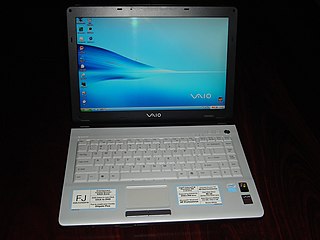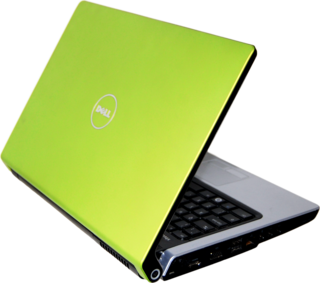Technical specifications
The lineup featured a 13.3" 1024x768 LCD screen that fit into the same weight and thickness as the company's 700 series, which had a smaller 12.1" screen (2.4 kg without optical drive or floppy drive, 2.7 kg with optical drive). Like the 700 series, the 800 series featured removable 3.5" floppy disk and CD-ROM drive and optional docking station. The internal modem was a 56 kbit device.
The Sony Vaio 700 series were Sony's first Vaio branded laptops, starting with the 705 and 707 models, launched in Japan on July 1, 1997, and subsequently in the United States.

In computing, an optical disc drive (ODD) is a disc drive that uses laser light or electromagnetic waves within or near the visible light spectrum as part of the process of reading or writing data to or from optical discs. Some drives can only read from certain discs, but recent drives can both read and record, also called burners or writers. Compact discs, DVDs, and Blu-ray discs are common types of optical media which can be read and recorded by such drives. Optical disc drives that are no longer in production include CD-ROM drive, CD writer drive, combo (CD-RW/DVD-ROM) drive, and DVD writer drive supporting certain recordable and rewritable DVD formats. As of 2015, DVD writer drive supporting all existing recordable and rewritable DVD formats is the most common for desktop PCs and laptops. There are also the DVD-ROM drive, BD-ROM drive, Blu-ray Disc combo (BD-ROM/DVD±RW/CD-RW) drive, and Blu-ray Disc writer drive.

A floppy disk, also known as a floppy, diskette, or simply disk, is a type of disk storage composed of a disk of thin and flexible magnetic storage medium, sealed in a rectangular plastic enclosure lined with fabric that removes dust particles. Floppy disks are read and written by a floppy disk drive (FDD).
The launch model, the PCG-808, was equipped with a Mobile Pentium II 266 MHz CPU, a 4 GB hard drive, 64 MB of RAM and was priced at $3699. [1] A lower-end 803 model, with a 233 MHz Pentium II, was also sold in Japan. The GPU for all models was the NeoMagic MagicMedia 256 AV with 2.5 MB of RAM.

A graphics processing unit (GPU) is a specialized electronic circuit designed to rapidly manipulate and alter memory to accelerate the creation of images in a frame buffer intended for output to a display device. GPUs are used in embedded systems, mobile phones, personal computers, workstations, and game consoles. Modern GPUs are very efficient at manipulating computer graphics and image processing. Their highly parallel structure makes them more efficient than general-purpose CPUs for algorithms that process large blocks of data in parallel. In a personal computer, a GPU can be present on a video card or embedded on the motherboard. In certain CPUs, they are embedded on the CPU die.
NeoMagic Corporation OTC Pink: NMGC is a fabless semiconductor company and supplier of low-power audio and video integrated circuits for mobile use (MagicMedia).









